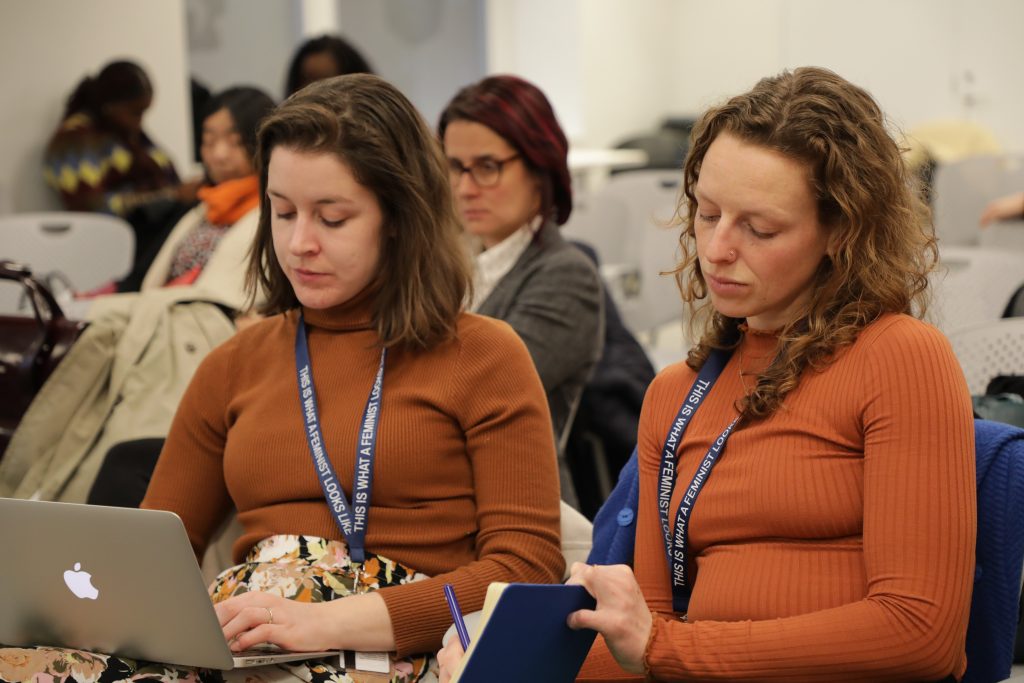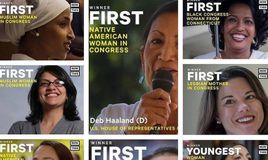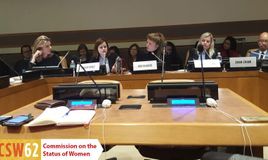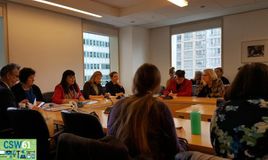Blog CSW67 side event “Reality check! Accelerating gender justice and sexual and reproductive health and rights through digital technologies.”

Pictures: Lara Yazbeck
On Tuesday March 14th 2023, I attended the side-event on the use of digital technologies to increase gender justice and sexual and reproductive health and rights (SRHR). On this snowy night, the panellists gave interesting insights on ways in which women and girls can claim their SRHR in Middle Eastern and North African countries (MENA).
The event builds on the findings of UNICEF, UNFPA and the Masarouna project. Katinka Moonen, Oxfam explains ‘This is a regional program in MENA, that works with and for young people, so they can claim their SRHR. So far, the project has reached more than one million young people with accurate and comprehensive SRHR information, both online and offline. However, it is hard work due to the restrictions and backlashes we are facing when addressing the topic’.

Obstacles for SRHR in the MENA region
SRHR in our country is usually perceived as a personal topic, explains Hayat Mirshad (Co-founder and executive director at Fe-Male). It is not much discussed in public, because it’s still a taboo. Culture and health are intertwined. It’s about patriarchal and stereotypical social norms, attitudes and perceptions. There is a lot of stigma and shame around topics such as menstruation. This is banning women and girls from access to knowledge and information. Mirshad: ‘’We are trying to explain that these issues are political.’’
In Lebanon, it is difficult to talk about these topics within the current economic situation. Crystine Mhanna (journalist at mediaplatform Raseef22) states that the main response when talking about SHRH is ‘now is not the time, we have more urgent issues to talk about.’ But of course, this topic is a priority, and a result of this situation’.
When we were speaking to girls and women in Iraq as we wanted to develop a platform for them, it became very clear that SRHR is less of a taboo for girls than for their caregivers, Girls have a clear hunger for more information, explains Catherine Leila Poulton (UNICEF).
Technology used to break barriers
Poulton: Because of this hunger, we started to think about virtual safe spaces for women and girls where services, information and networks are provided. But there wasn’t a trusted online source. Now, we are creating these virtual safe spaces where they can get information on SHRH and connect to other women. The virtual platform Laaha was launched on the 6th of March. ‘’To deal with the stigmatization of women and girls, we entirely co-designed these spaces, so content, images everything is co-designed.’’, Poulton explains. This is why platforms are different in different regions, because every place is different. Also, considering that girls are often sharing devices or do not have a private space to consult information, we created an exit button. When you click it, the browser’s history is immediately deleted, and you go back to the Google homepage.
Roadblocks and opportunities
Besides the general backlash against sexual and reproductive health and rights, the question of online safety is still concerning, Poulton explains. Women do not feel safe in the digital spaces, but also being seen on a phone can be dangerous for women and girls. Moreover, girls have less access to phones and the internet. Azelmat confirms this: there are still two billion women offline and because of backlash and harassment women are dropping off.
Mirshad: Because of the backlash, we try to decentralize the movement. So, we expand the work in remote areas where we try to reach adolescent girls. They are the change makers and hope for the future. It’s about awareness raising and knowledge production. For Mirshad, engagement starts through communities. When friends or family members say ‘come join us’.

The role of tech giants
Technology has the potential to support feminist movements, according to Emily Krasnor (UNFPA). However, this event is called Reality Check, Krasnor laughs, and tech giants’ motto often is ‘more is better’. This doesn’t result in safe responses for women and girls. What we need, is safety and privacy by design. We shouldn’t wait until harm has been done. Therefore, co-design is important. The technology sector should work together to reduce gender-based violence. This is difficult, because there is no common safety foundation, to check whether technological innovations are safe. Therefore, the UNFPA created a guidance on safe and ethical use of technology, to address gender-based violence.
Journalists reporting on SRHR
According to Mhanna, safety comes first when working on sensitive topics in the Arab Region. We should start with ourselves and write our personal stories. What are we struggling with on a daily basis. ‘’Journalists sharing how they feel on a certain topic has been impactful, because in the first place, it’s about people.’’ Mirshad: ‘’as Fe-Male, we are building toolkits for journalists to implement a gender sensitive approach. So, we keep an eye on media content and try to engage other media outlets on these topics.’’
To me, this side event was indeed a reality check. The panellists made it very clear that sexual and reproductive health and rights and digital aspects cannot be separated when we are talking about feminism and rights.
This Masarouna side-event was organized by Katinka Moonen and Michelle Do Campo (Oxfam), and moderated by Marwa Azelmat(RNW Media)
Atria and WO=MEN are jointly responsible for the coordination of input from civil society to the governmental delegation during the 67th session of Commission on the Status of Women in New York. Follow us on Twitter: @AtriaNieuws and @genderplatform.




